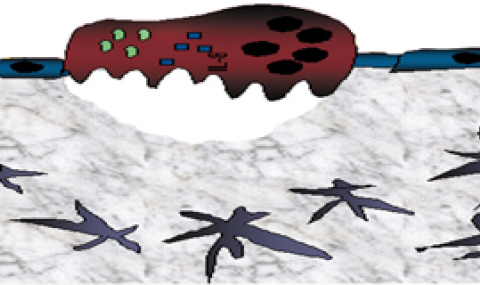How bone marrow (BM) stem cells replenish the blood with mature cells while maintaining the reservoir of undifferentiated stem cells, is poorly understood. We report that murine leukocyte production and BM stem cell maintenance are regulated by light and darkness cues. We identified two daily peaks of BM stem and progenitor cell (HSPC) proliferation: the morning peak following light initiation (11 AM, ZT5) and the night peak following darkness (11 PM, ZT17). Both peaks are preceded by a transient elevation of tumor necrosis factoralpha (TNFα) in the BM at 7 AM and at 7 PM, leading to increased reactive oxygen species (ROS) in HSPC and inducing their cycling. Reduced HSPC levels were observed either following ROS inhibition or in TNFα deficient mice. TNFα elevation augmented the levels of the TNFα converting enzyme (TACE) levels on HSPCs, promoting BM TNFα shedding. Interestingly, transient TNFα elevation was induced by switching light to darkness and vice versa, suggesting a role for TNFα as an internal mechanism of alert, preparing HSPC to cycle upon demand. While the morning HSPC peak was accompanied by increased egress and differentiation, the night peak was associated with retention and low differentiation. Norepinephrine (NE) generation has been shown to be driven by lightinduced cues from the brain and to induce stem cell egress from the BM during the morning peak (MendezFerrer et al, Nature 2008), while melatonin is an antioxidant that is mainly produced following the onset of darkness. We found that although NE and melatonin are continuously present in the BM, NE levels are predominantly augmented following initiation of light while melatonin is mostly elevated during the night. Administration of melatonin or inhibition of the sympathetic nervous system by β3adrenergic receptor antagonist during the morning induced HSPC retention, decreasing their morning differentiation and egress. In accordance, injection of NE during the evening induced HSPC egress and differentiation at night. Taken together, these results reveal that TNFα via ROS generation regulates both light and darkness peaks of stem cell proliferation in the BM. However, the nervous system via NE secretion further drives their maturation and egress only during the morning peak. Looking for mechanisms of HSPC protection which are essential to avoid BM exhaustion, we found that melatonin prevented their differentiation and egress thus maintaining them in a primitive state during the darkness peak. Concomitant with the night peak, we also observed increased BM levels of rare activated αSMA/Mac1 macrophage/monocyte cells. This population maintains HSPC in a primitive state via COX2/PGE2 signaling that reduces ROS levels and increases BM stromal CXCL12 surface expression (Ludin et al, Nat. Imm. 2012). The high melatonin levels at night induced PGE2 signaling in the BM stem cell niche, regulating COX2 high αSMA/Mac1 macrophages, which restored low ROS levels, preventing stem cell differentiation and egress. Murine BM leukocytes differentiate predominantly during the light time and are therefore more responsive to inflammatory challenges during this time frame. Mimicking bacterial infections, endotoxininduced mortality was shown to correlate with administration time, with very high mortality in mice treated at noon and very low mortality following midnight challenge (Halberg et al, Exp boil Med, 1960). We found that LPS administration in the afternoon resulted in a dramatic increase in BM neutrophils and monocytes production and recruitment which is lethal, in contrast to LPS injection at midnight with no immune activation. Reducing differentiation in the BM during the morning peak by administrating β3adrenergic receptor antagonist, melatonin or ROS inhibition, all decreased the levels of myeloid cell production and recruitment following LPS challenge in the afternoon. Our results revealed that the morning peak involves HSPC proliferation, differentiation and egress, allowing HSPC to replenish the blood and the immune system with mature leukocytes on a daily basis. In contrast, the night peak induces HSPC proliferation with reduced differentiation and egress, allowing the renewal of the BM stem cell pool. In summary, we have identified two daily peaks in BM HSPC levels which are regulated via light and darkness cues that impact daily blood cell production, host immunity and renewal of the BM stem cell reservoir.

Dynamic Networking between Stem Cells & Bone Marrow Microenvironment


